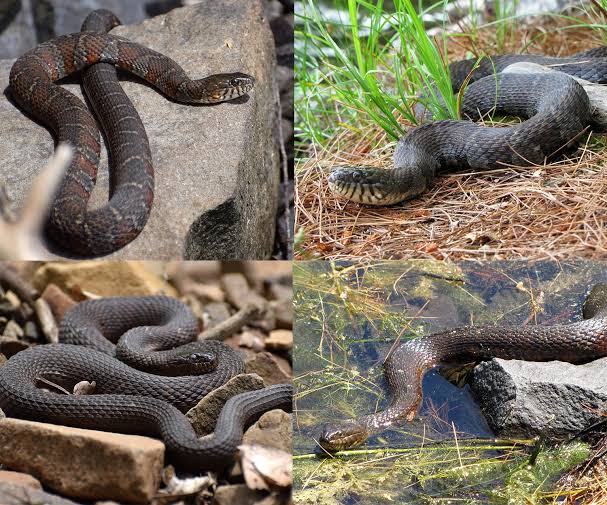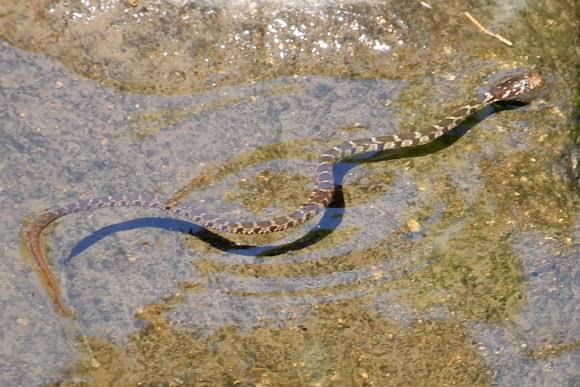Water snakes are special kinds of snakes that live near water. They are good swimmers and like to be close to ponds, rivers, or lakes. These snakes are not venomous, which means they don’t have poison in their bite. They come in different colors like brown, green, or gray, helping them blend in with their surroundings.
These snakes eat various things. Some of them like fish, while others enjoy frogs or small animals. They are quite clever hunters, using stealth to catch their prey. Water snakes are not harmful to people. Sometimes, though, they might seem scary because of their looks, but they usually just want to be left alone. They’re shy and try to hide from humans most of the time.
These snakes are important for the environment. They help control the population of certain animals by eating them. Also, they are part of the food chain, meaning other animals eat them too. During colder times, water snakes like to find warm places to stay. They might hibernate, which is like a long sleep to survive the cold weather.
It’s important to remember that even though they might seem a bit frightening, water snakes are just living their lives in the habitat they call home. Understanding and respecting them is a key part of coexisting with nature.
Water snakes have some cool ways to defend themselves. When they feel threatened, they might release a smelly musk or even play dead to avoid danger. These tricks help them stay safe from predators. Unlike some other snakes, water snakes don’t lay eggs on land. Instead, they give birth to live babies. A mama water snake can have lots of babies at once, sometimes up to 30 little ones!
Their bodies are designed for swimming. They have flattened tails that work like paddles, helping them glide smoothly through the water. Also, their scales are special—they’re not as rough as other snakes, which helps them move easily when swimming.
Water snakes are a part of nature’s balance. They fit into their ecosystems by eating certain animals and becoming food for others. They contribute to the circle of life in their habitat. Taking care of their homes is crucial for water snakes. Pollution and habitat destruction can harm them and their environment. Preserving the water they live near is important for these snakes to survive and thrive.
Appreciating these creatures and learning about their role in nature is an exciting way to understand the world around us. Studying water snakes helps us appreciate the diversity of life on our planet.
Read Also: The Benefits of Animal Shelter
Appearance and Features of Water Snakes

Water snakes have sleek bodies that are perfect for swimming. They can grow to different lengths, some shorter, around 2 to 3 feet, while others can be longer, reaching up to 4 to 5 feet. Their bodies are slender and smooth, and they have eyes on the top of their heads, which allows them to see while mostly submerged in water.
Their colors can vary, but they often blend in with their surroundings. Some might have patterns or stripes on their bodies, while others might be a solid color. Their scales are not as rough as some other snakes, giving them a smoother appearance, especially helpful when gliding through the water.
One fascinating thing about water snakes is their ability to shed their skin as they grow. Like many other snakes, they shed their old skin to allow for new growth. This process helps keep their skin healthy and enables them to grow without any constraints from the old skin.
History and Origin of Water Snakes

Water snakes have been around for a long, long time, but their exact origin is not entirely clear. These snakes belong to a group called Nerodia, which includes various species found in different parts of North and Central America.
They’ve adapted to living near water over many, many years. The history of water snakes is intertwined with the habitats they occupy. They’ve evolved to become excellent swimmers and hunters, finding their place in ecosystems around bodies of water like rivers, lakes, and ponds.
While specific details about their ancient history might not be well-documented, their presence in these aquatic environments showcases their successful adaptation and survival strategies developed over generations. They’ve learned to thrive in their habitats, becoming an essential part of the ecosystems they inhabit.
Read Also: History and Development of Humane Society
Health and Lifespan of Water Snakes

Water snakes, like many animals, can face health challenges in their natural environment. They might encounter parasites or diseases that can affect their well-being. Additionally, pollution or habitat destruction can lead to health issues for these snakes, impacting their ability to find food or suitable places to live.
Their lifespan varies depending on their species and environment. On average, water snakes can live anywhere from 5 to 10 years in the wild. However, some can live longer if they have access to a healthy environment and ample food sources. Factors like predators, diseases, and human interference can affect their lifespan.
Maintaining clean water sources and preserving their habitats are crucial for their health and longevity. These efforts not only benefit water snakes but also contribute to the overall health of the ecosystems they inhabit.
Nutrition and Feeding Mode of Water Snakes
Water snakes have diverse diets, and what they eat depends on their species and habitat. Many water snakes primarily consume fish. They’re excellent hunters underwater, using stealth and patience to catch their aquatic prey. They might also feed on frogs, tadpoles, small mammals, or even other smaller snakes.
These snakes are not venomous, so they rely on their bodies and hunting skills to catch their meals. They often ambush their prey, waiting patiently for the right moment to strike.
Their digestive systems are efficient at processing their food. After a meal, they might find a warm place to bask in the sun to aid digestion. Being cold-blooded creatures, they rely on external heat sources to regulate their body temperature, which also helps with digestion.
Water snakes play an important role in controlling populations of certain animals by keeping their numbers in check through their feeding habits. This helps maintain a balance in the ecosystem where they live.
Importance of Water Snakes

Water snakes hold importance in their ecosystems. They contribute to the balance of nature by regulating the populations of their prey animals. By controlling the numbers of fish, frogs, and other small creatures they feed on, water snakes indirectly help maintain the health of these populations and the overall balance of their habitats.
They also serve as food for other animals like birds of prey, larger snakes, or mammals. In this way, they become part of the food chain, ensuring the survival of other species.
While they might not have direct uses for humans, understanding and appreciating their role in nature is crucial. Learning about these snakes helps us understand the complexity of ecosystems and highlights the interconnectedness of all living things in the natural world. Preserving their habitats and the environments they live in is vital for the overall health of the ecosystem.
Here are some additional points regarding the importance of water snakes:
1. Environmental Indicators: Water snakes can serve as indicators of environmental health. Their presence or absence in certain habitats can signal the condition of the ecosystem. Healthy populations of water snakes can suggest a balanced and thriving environment.
2. Research and Education: Studying water snakes helps scientists and researchers understand various aspects of ecology, behavior, and adaptation. This knowledge contributes to broader studies in biology and conservation, aiding in the protection of not only water snakes but also other species in similar habitats.
3. Ecotourism and Education: In some areas, water snakes attract nature enthusiasts and tourists interested in observing local wildlife. This interest can lead to educational opportunities about the importance of these snakes and their habitats, fostering a greater appreciation for biodiversity and conservation efforts.
4. Natural Pest Control: By preying on certain animals, water snakes indirectly help in controlling populations of pests like insects or small rodents, contributing to a more balanced ecosystem and potentially reducing agricultural damage caused by these pests.
5. Biodiversity Maintenance: Every species plays a role in maintaining biodiversity. Water snakes, by being a part of their ecosystems, contribute to the overall richness and diversity of life in their habitats.
Understanding the multifaceted importance of water snakes helps us recognize the significance of conserving their habitats and protecting their populations, contributing to the well-being of the environment as a whole.
Read Also: The Impact of Business Waste Recycling Services on Our Environment

